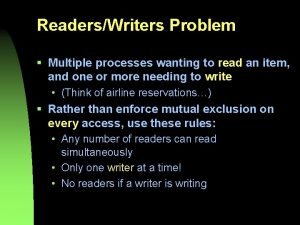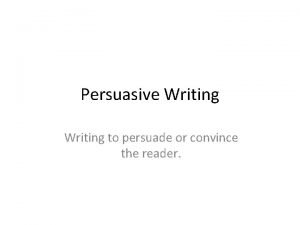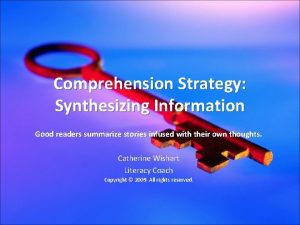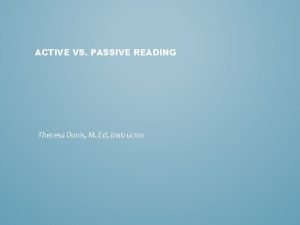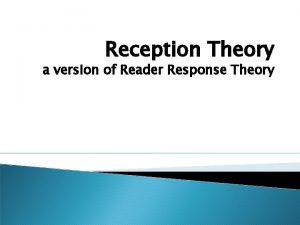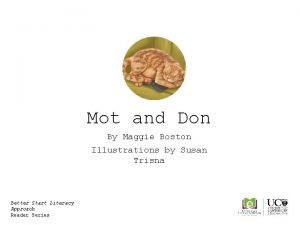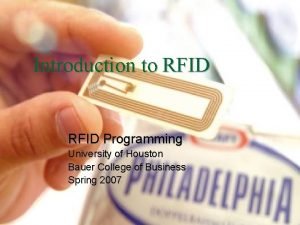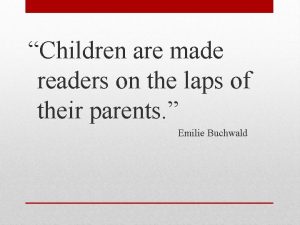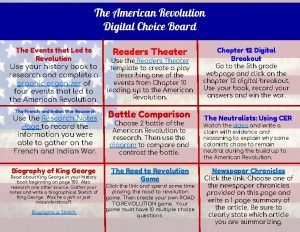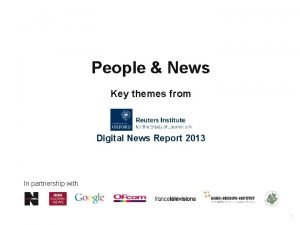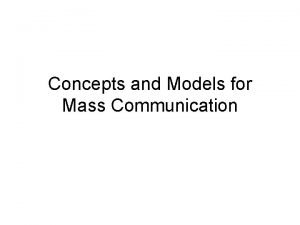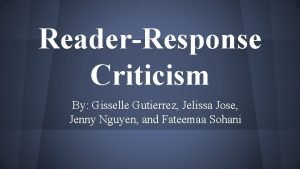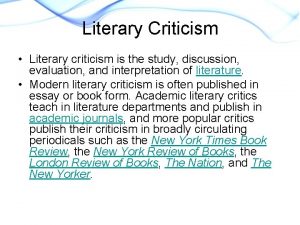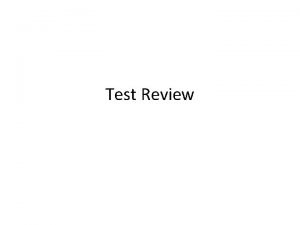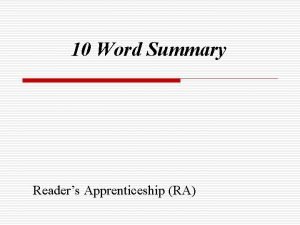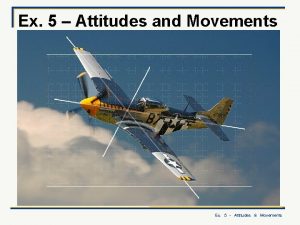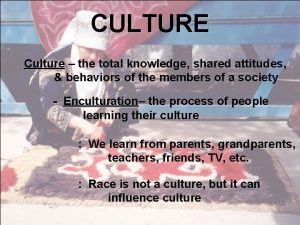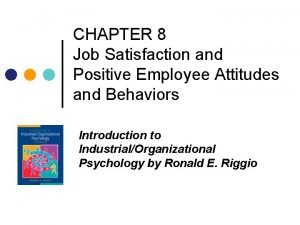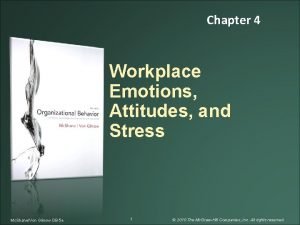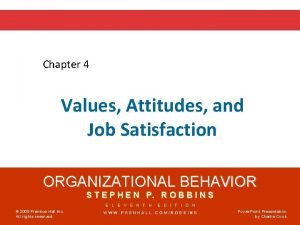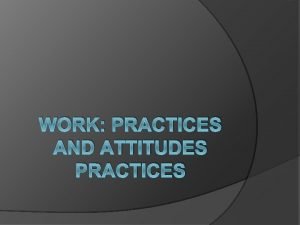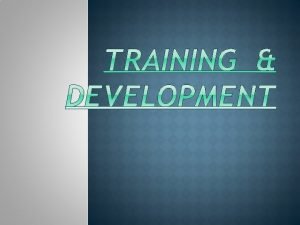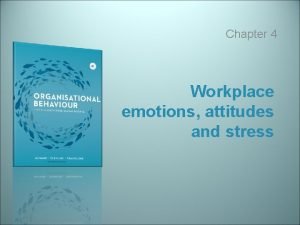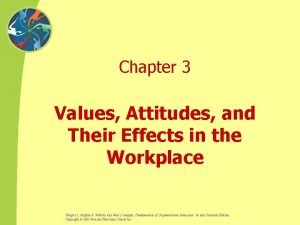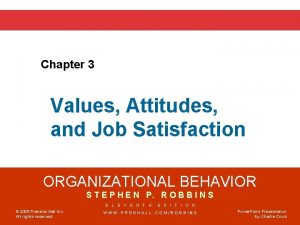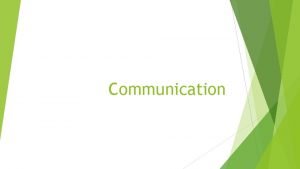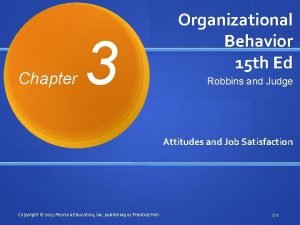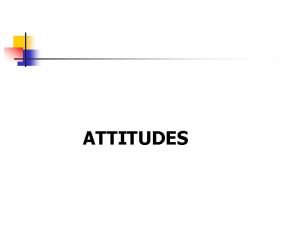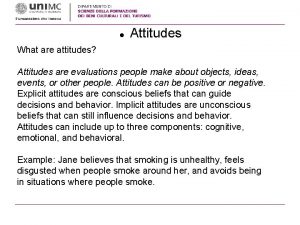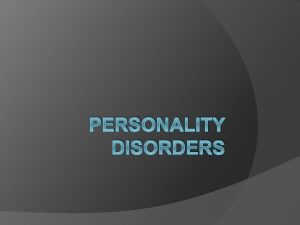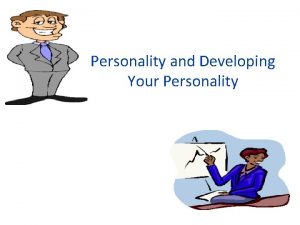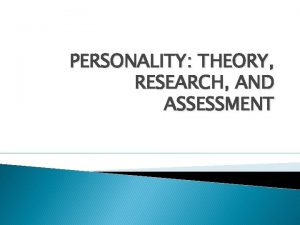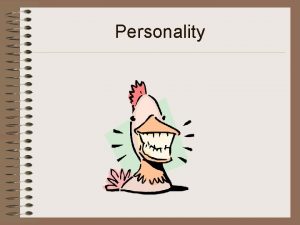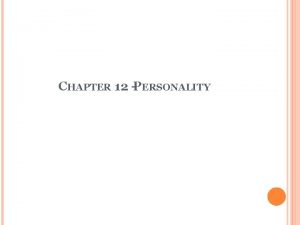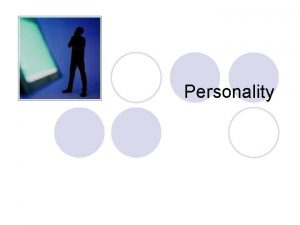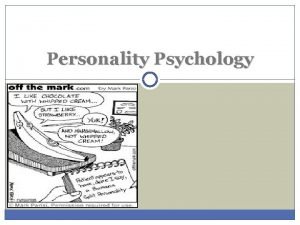Section 4 Personality and Attitudes Leaders are Readers

















































- Slides: 49

Section 4: Personality and Attitudes

Leaders are Readers Peter Drucker (1974)- Management: Tasks, Responsibilities, Practices “An employer has no business with a man’s personality. It is immoral as well as an illegal intrusion of privacy. It is an abuse of power. Employment is a specific contract calling for a specific performance…an employee owes no “loyalty”, he owes no “love” and no “attitudes”— he owes performance and nothing else. ”

The Meaning of Personality Definition: • The unique qualities of an individual and how those qualities affect understanding of themselves and others The Role of Heredity and the Brain • External appearance – due to genetics • Internal characteristics – nature vs. nurture – Twin Studies show that 40% are fixed… 60% developable

What is Personality? How would you describe it? Is it inherited? • Are you more like your mom or dad? Does it change over time? Does it change depending on who you are with?

Personality Theories Trait Theory - understand individuals by breaking down behavior patterns into observable traits Psychodynamic Theory - emphasizes the unconscious determinants of behavior Humanistic Theory - emphasizes individual growth and improvement Integrative Approach - describes personality as a composite of an individual’s psychological processes

Personality- Summary The Four Perspectives on Personality Perspective Psychoanalytic Behavior Springs From Assessment Techniques Unconscious conflicts between pleasure-seeking impulses and social restraints Evaluation Projective tests aimed at revealing unconscious motivations A speculative, hard-to-test theory with enormous cultural impact Trait Expressing biologically (a)Personality inventories influenced dispositions, such that assess the strengths as extraversion or introversion of different traits (b)Peer ratings of behavior patterns A descriptive approach criticized as sometimes underestimating the variability of behavior from situation to situation Humanistic Processing conscious feelings about oneself in the light of one’s experiences A humane theory that reinvigorated contemporary interest in the self; criticized as subjective and sometimes naively self-centered and optimistic Social-cognitive Reciprocal influences between people and their situation, colored by perceptions of control (a)Questionnaire assessments (b)Empathic interviews (a)Questionnaire assessments Art interactive theory that inof people’s feelings of control tegrates research on learning, (b) Observations of people’s cognition, and social behavior, behavior in particular criticized as underestimating situations the importance of emotions and enduring traits

Start with Nature, Then Add Nurture How much of personality is based on genetics? How much of your personality was developed, learned, strengthened over time? Socialization trains us how to act in relationship to others. Parents are our first teachers.

Is Personality Changeable?

Socialization Tactics that Change Personality Challenging jobs Relevant Training Timely and consistent feedback Mentoring relationships Orientation programs Work group morale Socialization does have a long run impact, but not on everything.

Introduction to Personality Traits Thousands of “Traits” Significant Overlap Futile to Study Personality Barrick and Mount Propose the “Big 5” Big 5 now Widely Accepted and Used Other Personality Traits or “Individual Differences” Still Researched

Big Five Personality Traits Sources: P. T. Costa and R. R. Mc. Crae, The NEO-PI Personality Inventory (Odessa, Fla. : Psychological Assessment Resources, 1992); J. F. Salgado, “The Five Factor Model of Personality and Job Performance in the European Community, ” Journal of Applied Psychology 82 (1997): 30 -43.

Core Self Evaluation Traits Self-Esteem • Your belief as to your competence and your image • High self-esteem – positive attitudes, feelings, and satisfaction Locus of Control Generalized Self Efficacy Neuroticism (emotional stability)

Personality Characteristics in Organizations Self-Esteem Feelings of Self Worth Success tends to increase self-esteem Failure tends to decrease self-esteem

Personality Characteristics in Organizations Locus of Control Internal External I control what happens to me! People and circumstances control my fate!

Outcomes of Personal Control Learned Helplessness Uncontrollable bad events Perceived lack of control Important Issue • Nursing Homes • Prisons • Colleges Generalized helpless behavior

Personality Characteristics in Organizations Generalized Self-Efficacy - beliefs and expectations about one’s ability to accomplish a specific task effectively Sources of self-efficacy • Prior experiences and prior success • Behavior models (observing success) • Persuasion • Assessment of current physical & emotional capabilities

Personality Characteristics in Organizations Self-Monitoring Behavior based on cues from people & situations High self monitors • flexible: adjust behavior according to the situation and the behavior of others • can appear unpredictable & inconsistent Low self monitors • act from internal states rather than from situational cues • show consistency • less likely to respond to work group norms or supervisory feedback

Who Is Most Likely to. . . Low-self monitors High-self monitors Get promoted Accomplish tasks, meet other’s expectations, seek out central positions in social networks Change employers Self-promote Make a job-related geographic move Demonstrate higher levels of managerial self-awareness; base behavior on other’s cues and the situation

Leaders are Readers Swim with Sharks Without Being Eaten Alive Harvey B. Mackay (2005) “…to connect with celebrities you need to avoid the “fan syndrome” and instead talk to them about their interests. ”

Personality Characteristics in Organizations Positive Affect - an individual’s tendency to accentuate the positive aspects of oneself, other people, and the world in general Negative Affect - an individual’s tendency to accentuate the negative aspects of oneself, other people, and the world in general

Personality Characteristics in Organizations A strong situation can overwhelm the effects of individual personalities by providing strong cues for appropriate behavior

Personality Characteristics in Organizations Strong personalities will dominate in a weak situation

How is Personality Measured? Projective Test - elicits an individual’s response to abstract stimuli Behavioral Measures - personality assessments that involve observing an individual’s behavior in a controlled situation Self-Report Questionnaire - assessment involving an individual’s responses to questions Myers-Briggs Type Indicator (MBTI) - instrument measuring Jung’s theory of individual differences.

Myers-Briggs Type Indicator Based on Carl Jung’s work • People are fundamentally different • People are fundamentally alike • People have preference combinations for extraversion/introversion, perception, judgment Briggs & Myers developed the MBTI to understand individual differences

MBTI Preferences

Does Personality Matter? Big 5, CSET, MBTI Matter in: • Certain jobs (sales, QA, leadership) • At certain times (e. g. , status quo, crisis) • More than performance? Honesty Theft Absenteeism Turnover Commitment/Satisfaction

Discussion Questions Do you feel organizations should hire people based upon their personality characteristics? What are the issues with this? When people are hired into a job (e. g. , engineering) do you think the personality is attracted to the job, or the job shapes the personality? Why? “I didn’t used to me this way until I started working here. ”

Today’s Learning Objectives Describe the meaning of attitudes and their emotional, informational, and behavioral components. Explain the antecedents of workrelated attitudes, the functions they perform, and how they are changed.

The Nature and Dimensions of Attitudes “Attitudes” • Persistent tendency to feel and behave in a particular way towards some object Characteristics of Attitudes • They tend to persist unless something is done to change them. • They can fall anywhere along a continuum from very favorable to very unfavorable. • They are directed toward some object about which a person has feelings and beliefs.

Attitude Model genetics Informational/ Cognitive (i. e. beliefs) Attitude socialization Behavior Affective (i. e. emotions) Measurable in the brain with f. MRI learning observable

Job Attitudes and Actual Behavior • The belief, attitude, intention sequence is presumably followed by actual behavior. • This traditional model suggests that behaviors (including job performance) are largely influenced by job attitudes. (e. g. , absenteeism) • Recently, this traditional model has been questioned as being too simple and some more comprehensive alternatives have been developed.

The Nature and Dimensions of Attitudes Components of Attitudes • Emotional – feelings about an object • Informational – beliefs and information about the object • Behavioral – tendencies to behave in a particular manner towards an object (usually behavioral intentions) Only behavioral can be directly observed

The Nature and Dimensions of Attitudes (Continued) Antecedents of Work-Related Attitudes: PA/NA • Positive affect – overall sense of well-being, engaged, and experience positive attitudes • Negative affect – nervous, tense, anxious, and distressed

History of Job Satisfaction Based in history of Job Satisfaction Formal research began in mid-1930’s • 1932 I/O textbooks had no mention of job satisfaction or organizational commitment • By 1972 over 3000 articles published specifically exploring worker attitudes Why interest developed • Methodological breakthroughs Survey methods • Statistical techniques

How do Americans feel about going to work? Most Americans like their jobs overall People are relatively satisfied with the nature of the work itself: • How interesting it is • Having lots of contact with people People less happy with rewards • Pay • Benefits • Chances for promotion

Determinants of Job Satisfaction Copyright 1999 by Brent Smith, Ph. D.

Job Satisfaction Influences on Job Satisfaction • • • Mental challenge in the work itself Pay Promotions Supervision Work Group Working Conditions

Why all the fuss? Cultural interest • Something most of us believe we are entitled to or at least desire from our work Functional (practical) reasons • Link to important organizational outcomes Performance…sometimes Turnover Absenteeism Counterproductive behaviors

Job Satisfaction Outcomes of Job Satisfaction • • (Continued) Satisfaction and Performance Satisfaction and Turnover Satisfaction and Absenteeism Other Effects and Ways to Enhance Satisfaction

Job Satisfaction and Performance Is a happy worker a productive worker? Correlations positive and low to moderate • . 16 with overall satisfaction in individual studies • . 30 with overall satisfaction in meta-analytic studies • . 10 with specific facets Why is the association not larger?

Organizational Commitment The Meaning of Organizational Commitment • Affective • Continuance • Normative

Organizational Commitment has been related to many different job outcomes Overall job satisfaction Performance (depends Organizational Commitment . 53. 11 on financial need) Turnover -. 28 Conscientiousness . 67 Job involvement . 50

Organizational Commitment Guidelines to Enhance Organizational Commitment • • • People-first Communication Mission Org. Justice Create a community Support employee development Organizational Citizenship Behaviors (OCBs)

Managing Employee Turnover through Attitudes Satisfaction Commitment Embeddedness

Psychological Ownership Multi-dimensional Construct • • • self-efficacy accountability belongingness self identity Negatively loaded “territoriality” Correlates • Leadership • Empowerment • Performance

Psychological Ownership Measurement I feel I need to protect my ideas from being used by others in my organization. I am confident in my ability to contribute to my organization’s success. I would challenge anyone in my organization if I thought something was done wrong. I feel I belong in this organization. I feel this organization’s success is my success.

Discussion Do we care if employees are satisfied as long as they do their job well? Describe your current job: what steps could be taken to enhance job satisfaction?

Questions

Review What is personality? What are some common personality traits? Why should knowledge of personality matter to today’s managers? Would you say it is better to train personality or to select for personality? Describe Big 5, CSET, MBTI, Job Satisfaction, Organizational Commitment What are the components of an attitude? What is self monitoring and why is it important?
 Insidan region jh
Insidan region jh Critical reading meaning
Critical reading meaning P i e stands for persuade, inform, and enlighten.
P i e stands for persuade, inform, and enlighten. What is intensive reading
What is intensive reading Readers writers problem
Readers writers problem To convince the reader
To convince the reader Good readers making prediction by
Good readers making prediction by Maggie boston readers
Maggie boston readers Korean graded readers
Korean graded readers Persuasive appeals
Persuasive appeals Vivid readers
Vivid readers Synthesizing information allows a reader to
Synthesizing information allows a reader to Children are made readers on the laps of their parents
Children are made readers on the laps of their parents Passive reading means
Passive reading means Reader response theory example
Reader response theory example Maggie boston readers
Maggie boston readers Rifd readers houston
Rifd readers houston Children are made readers on the laps of their parents
Children are made readers on the laps of their parents Town contaminated moscow
Town contaminated moscow American revolution readers theater
American revolution readers theater ²www
²www Online readers
Online readers Concepts in mass communication
Concepts in mass communication Reader's goal in narration
Reader's goal in narration When readers struggle
When readers struggle The outsiders adapted for struggling readers
The outsiders adapted for struggling readers Teachers as readers
Teachers as readers Tenets of reader response theory
Tenets of reader response theory Formalism literary theory
Formalism literary theory Where the wild things are readers theater
Where the wild things are readers theater In which of these statements does henry use parallelism?
In which of these statements does henry use parallelism? Civil war readers theater
Civil war readers theater 10 word summary
10 word summary Module 79 ap psychology
Module 79 ap psychology New zealand values and attitudes
New zealand values and attitudes Personal attitudes and dispositions also shape behavior
Personal attitudes and dispositions also shape behavior Characteristics of quality culture
Characteristics of quality culture Cruise attitude
Cruise attitude The total knowledge shared attitudes and behaviors
The total knowledge shared attitudes and behaviors Positive employee attitudes and behaviors
Positive employee attitudes and behaviors Workplace emotions, attitudes, and stress
Workplace emotions, attitudes, and stress Values attitudes and job satisfaction
Values attitudes and job satisfaction Work practices and attitudes
Work practices and attitudes New knowledge attitudes and skills acquired in ojt
New knowledge attitudes and skills acquired in ojt Workplace emotions, attitudes, and stress
Workplace emotions, attitudes, and stress Values and attitudes in the workplace
Values and attitudes in the workplace Values attitudes and job satisfaction
Values attitudes and job satisfaction 5 unsafe attitudes and consequences
5 unsafe attitudes and consequences Communication is the exchange of
Communication is the exchange of Compare and contrast the major job attitudes
Compare and contrast the major job attitudes




